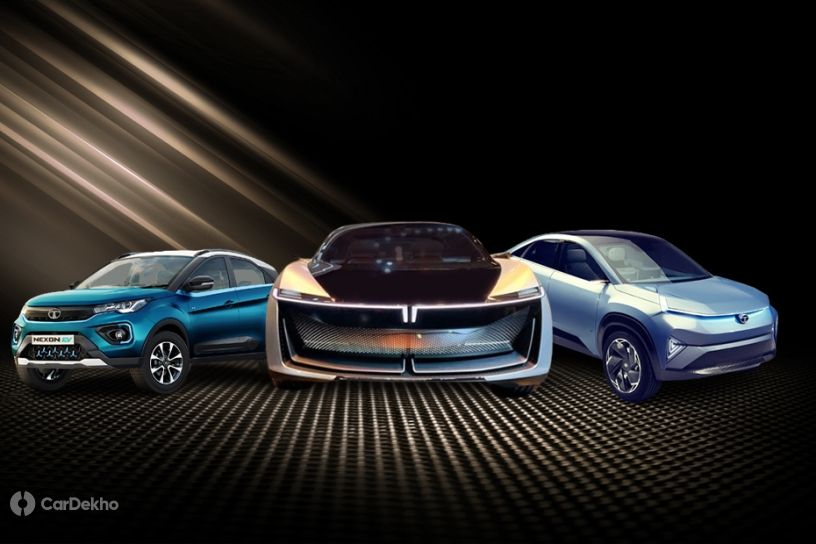Tata EV Platforms Explained: Gen1 vs Gen2 vs Gen3
Published On May 07, 2022 09:43 AM By Sonny
- Write a comment
Each platform represents a stage of Tata’s journey towards electrified mobility and we’ll explain what they’re about

Tata has been the leading brand for EVs in India for quite some time now thanks to a well positioned product that offers a practical range at affordable prices. In 2022, the brand debuted two new concepts previewing the future of Tata EVs, each based on new architectures called Gen2 and Gen3. Let’s dive into what makes them different from each other and from the Gen1 EV platform.
What kind of models will be based on each platform?

The Gen1 platform underpins existing Tata EVs, i.e., the Nexon EV and Tigor EV. These are electric variants of existing combustion-engine models from Tata.

The Gen2 architecture is an evolutionary upgrade over its predecessor and is scalable to suit models of various sizes. It will also be able to spawn both EVs and ICE models, like the Gen1. However, this platform focuses more on EV compatibility than ICE compared to Gen1.
Related: Tata Will Launch The Curvv ICE (Petrol And Diesel) As A Hyundai Creta Fighter

Meanwhile, Gen3 is dedicated to EVs only. Hence, it has a skateboard type design with increased space between the axles to house the battery pack under the flat floor. Additionally, EVs based on the Gen3 platform will be aimed at markets outside of India as well. Thus, we can expect to see Tata introduce premium EVs in the future.
Expected range from EVs of each platform
The two models offered on the Gen1 platform so far are both sub-4m offerings. They both offer a certified range of just over 300km and their batteries can be charged using 50kW DC fast chargers. (The latest model on the Gen1 architecture is the Nexon EV Max which uses a larger battery pack for a higher range closer to 400km.)

The EV-focused Gen2 architecture can accommodate newer drivetrain systems and larger battery packs for both better performance and increased range. Tata states EVs based on this platform will deliver between 400km and 500km of certifiable range. They would also be capable of faster charging from both AC and DC sources.

With Gen3 EVs, Tata is aiming for a minimum certifiable range of 500km. It will also be equipping them with the electric infrastructure for hyper charging capabilities to be able to add up to 500km of range in 30 minutes. At present, there is no EV priced below Rs 30 lakh with a claimed range of 500km.
Also read: Top 7 Things You Need To Know About The Tata Gen3 EV Platform
Added capabilities and functionalities
While the Tata EVs based on the Gen1 platform are quite straightforward in their application of the electrified powertrain, the newer architectures are capable of doing more. The Gen2 platform will underpin EVs that can share their charge with other EVs, or use it to power household appliances using a 3-pin socket. This feature is known as vehicle-to-load, or vehicle-to-vehicle charging.

This image is for representational purposes only
Tata stated its Gen2 EV models will feature enhanced connectivity for telematic and over-the-air updates while also being capable of running more advanced computing systems to potentially offer ADAS features.
The Gen3 EV is expected to be capable of autonomous driving tech beyond the ADAS features currently offered in mass market cars priced below Rs 20 lakh. This architecture also promises safer EVs thanks to its structural design while also offering better protection to the battery from all types of climates and terrains.

However, the biggest advantage of the Gen3 architecture is the ability to offer far more interior space from the given proportions. As seen in the Avinya concept, it is able to offer cabin space which is comparable to the Harrier while being similar in length to the Hyundai Creta.
When will the newer platforms reach the market?
The first model based on the Gen2 platform will be the production-spec version of the Concept Currv electric SUV coupe. According to Tata, the concept is almost ready for the road. The final market-ready version of the Currv is slated to arrive by 2024.

Surprisingly, the Gen3 EV is scheduled to arrive shortly after with a production-ready model by 2025. The first offering will be a market-ready version of the Avinya concept itself.

In the meantime, we can also expect more Gen1 EVs and or different versions with an extended range. The two models that have already been announced are the electric variants of the Altroz premium hatchback and the Punch micro SUV. Tata seems to be firmly on track for achieving its target of having 10 EVs in its lineup by 2025.
Also read: Long-range Tata Nexon EV To Be Called The ‘Nexon EV Max’
1 out of 1 found this helpful















